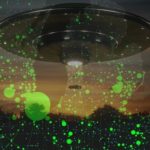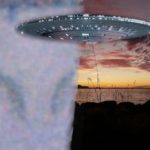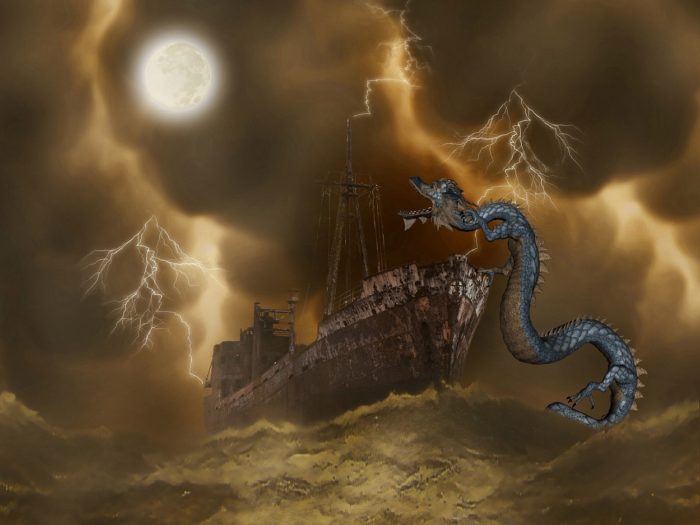
Monstrous Creatures Of The Deep
- By
- April 18, 2020
- September 30, 2021
- 21 min read
- Posted in
- Cryptozoology, Sea Monsters
We recently examined the bizarre incidents of several U-Boats in the First World War and their apparent encounters with huge, monstrous creatures that emerged from the depths of the icy waters. While there is obvious debate about the authenticity and accuracy of those encounters, there are multiple such incidents of mysterious creatures residing deep under the waves of the world’s oceans, seas, lakes, and rivers. And what’s more, these accounts go back centuries.
There is a saying that we know more about the Moon than we do about the goings-on of our own oceans. And when we stop to think about just how much of the planet is covered by water, it is easy to see why that saying is most likely very accurate.

Do deep sea monster really exist?
While many of the sightings we will examine here might be the product of confused and scared minds, or even simple misidentifications of an already known sea creature, the fact that so many people claim to see such strange and gigantic aquatic beasts surely requires that further, serious study should take place. Might there be more to these encounters than just overactive imaginations and tall tales? Might such creatures as the Loch Ness Monster, for example, really exist?
We should note that, while there is no doubt that the Loch Ness Monster is of interest to such a subject, we shall return to this particular creature in-depth in a future case study article.
We start, however, on the coasts and waterways of Canada, who appear to have more than their fair share of such creatures. Perhaps the Canadian conditions and elements will ultimately provide researchers with clues as to just what types of creatures are potentially out there, still undiscovered and officially unrecognized by science.
Contents
- 1 The Hunt For Cadborosaurus In The Waters Of British Columbia
- 2 The Many Legends Of The Ogopogo
- 3 Tales And Accounts Of Giant Squid
- 4 The Many Strange Aquatic Creatures Of The United States
- 5 The Bunyip Legends Of Australia
- 6 The Lake Tianchi Monster
- 7 The Monster Of Lake Tota
- 8 Russia’s The Brosno Dragon – An Aquatic Legend In Truly Ominous Surroundings!
- 9 The Mahamba Of The Democratic Republic Of Congo – Another Link To The Dinosaurs?
- 10 Another Example Of Myth And Legend Contain Partial Truths?
The Hunt For Cadborosaurus In The Waters Of British Columbia
Perhaps the best place to start our look into the murky world of huge, behemoth-like sea creatures is in the waters in and around British Columbia [1] in Canada. Not only is the region home to one of the strangest and genuine finds in terms of these monstrous aquatic beasts, but an article in the New York Times in early 2019 claimed that scientists researching the possibility of the existence of such a creature were about to undertake significant and serious searches for it.
Known as Cadborosaurus – although most often the Cadboro Bay Sea Monster – sightings in and around the British Columbia region have been in relative abundance. In fact, the co-founder of the British Columbia Scientific Cryptozoology Club (BCSCC), John Kirk, would claim there were “hundreds of sightings” of the creature.
Perhaps the most famous incident occurred in 1937 on Naden Harbor, when dockworkers managed to extract the carcass of a huge, strange animal from a dead whale. Photographs were taken of the creature (which you can see below). Some believed the animal was, in fact, a whale fetus, but others would claim that the carcass was distinctly “serpentine in aspect”.

Image of Cadborosaurus on display
And what’s more, the descriptions of the carcass, as well as what little detail can be seen in the grainy black and white photographs, match well with other sightings that have taken place over the years.
As recently as May 2019, for example, a partial carcass washed up on the shore of Victoria. According to the report, the strange creature had “skin like a shark, a reptilian snout, and a talk with what appears to be teeth growing from it”.
From these details, though, researchers are able to deduce the likely appearance of this seemingly elusive creature.
A Desire To Enter Cadborosaurus’ Existence On To The Scientific Record
According to researchers of the Cadboro Bay Sea Monster, it is likely to be between 40 to 50 feet in length when fully grown, and perhaps around 15 feet in length when young. It likely resides in deep water, and “embodies major characteristics of both Reptilia and Mammalia”. However, it is likely unable to sit neatly in either category. Essentially, it would appear that scientists would be dealing with an entirely different species.
Although the 1937 incident is perhaps the best known, there are many other cases in the area, with some dating back to the early 1880s (and there are almost certainly cases before that that are perhaps not reported or have been lost).
Ultimately, however, no definitive proof of the creature exists. Many of the other apparent finds of strange creatures that have washed ashore have been identified as other known creatures such as sea lions or basking sharks.
The sightings of the creatures in the British Columbia waters continue still today. And while the BCSCC will continue in their pursuit to find proof of it existence as well as its location, they wish to do so in order to catalog the creature and enter onto the scientific record. And they wish to do so before it, if indeed it does exist, dies out completely.
The short video below is just one piece of footage that claims to be of the mysterious Cadboro Bay Sea Monster.
The Many Legends Of The Ogopogo
Perhaps it is worth our time here looking at another apparent sea monster of the British Columbia region, that of Ogopogo who is claimed to reside in the waters of Lake Okanagan and is sometimes referred to as Canada’s Loch Ness Monster.
Sightings of the Ogopogo [2] stretch back to at least the late 19th century when in 1873 Susan Allison witnessed the strange “water demon” from her home near the water.
In 1926, multiple witnesses in up to 30 cars on a road along Okanagan Beach would report seeing the strange creature. That all the witnesses saw the creature at the same time is surely significant. A little over 20 years later in 1947 came another multiple witness sighting occurred. Several boaters would witness a serpent-like creature almost “30 feet in length, consisting of about five undulations”. It would eventually disappear under the water.
Just over a decade later in 1959, a pair of married couples out on the water would notice a “tremendous creature” with the head of a snake and a “blunt nose” which followed their motorboat for several minutes before finally going back beneath the water.
Perhaps one of the most intriguing Ogopogo accounts would unfold in 1978 when Bill Steciuk was driving his car across a bridge over Okanagan Lake. As he was doing so he would notice a strange movement in the water to his side. He would immediately bring his car to a halt. What’s more, his action would cause the vehicles behind him to stop also. As a result, both he and around 20 other onlookers would witness a creature with a strange head and “three black humps” moving along the surface of the water form around a minute. Like many other sightings, the creature then vanished back under the water.
The Wachlin Family Photograph, 1981
On the afternoon of the 24th June 1981, at around 1 pm, near Rattlesnake Island, the Wachlin family were about to take to the water in a rented ski boat. As they were preparing to set off, the noticed a water skier in the distance pass by them.
As they focused their attention on the skier, they noticed that a “creature surfaced directly in front” of them. They could not see the head, just several bumps in the water. Then, it began to move at a fast pace in the water. The witness would quickly turn their boat in the direction of the movement and began to head toward it cautiously.
As the boat neared it, it began to dive under the water “causing a large frothy whirlpool”. As the witness looked into the water, they could see the strange creature several feet under the water. They would claim the creature was either a “very dark green or black” color and at least 50 feet long.
The main witness did manage to snap a picture of the aftermath of the incident.
You can see that picture below.
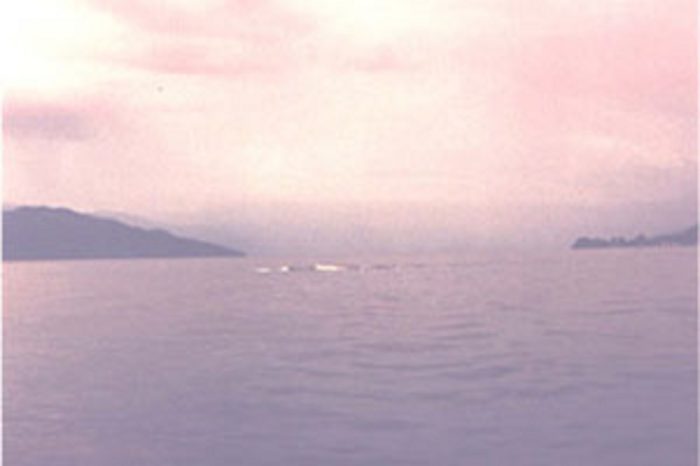
Does this image show a sea monster emerging from the water?
Ogopogo Sightings Continue Into The 2000s
As the 21st century unfolded sightings of the Ogopogo would continue.
Perhaps one of the most unnerving occurred in 2000 when Daryl Ellis, a marathon swimmer, would report “two large creatures” suddenly appearing at his side while he swam near Rattlesnake Island. He would describe them as being approximately 20 to 30 feet in length. They would stay at his side for several minutes before disappearing without incident.
However, Ellis would have another encounter with the strange creature, this time in Kelowna near the Okanagan Lake floating bridge. As he was swimming a bizarre creature with “an eye the size of a grapefruit” came to within several feet. It was Ellis’s opinion that the creature wished “to get a close look at him”. When Ellis described the latter sighting to a local artist, they would produce a painting of the creature. You can see that picture below.
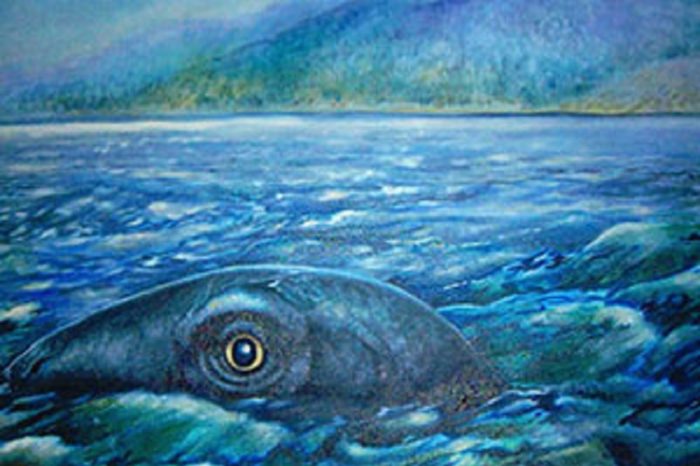
Depiction of the Ogopogo
In the same year, James Ivany would also witness a strange creature during a vacation in Okanagan Lake Provincial Park. Ivany had spent the night with a friend on the beach talking until dawn. It was around 5:30 am, a little after the sun had risen when Ivany would spot something strange in the water near Rattlesnake Island. He would later describe it as looking like “a submarine surfacing”.
His friend also witnessed the bizarre scene. As each of them watched, they noticed how fast it was moving. They would also guess that it was around 100 feet long. It remained in sight for approximately 30 seconds before disappearing out of sight, leaving only the disturbance of the water as a sign that it had been there. Ivany would quickly scan the lake noting there were no other vehicles on the water that could have contributed to the movement. Nor was there any wind or breeze.
Tales And Accounts Of Giant Squid
There is some evidence that “giant” squids or octopuses do exist in the depths of the world’s waters. Some have even been found in more recent times. However, as large as these species may be, they would still have no realistic chance of wrapping their tentacles around a ship or a submarine.
Might it be a case, then, especially when such gigantic creatures were known to humanity (generally speaking) that such sightings were built-up and exaggerated, perhaps innocently so, by those who had witnessed them? Or might such gigantic specimens really exist, and have only been witnessed by a very select few, who like those who witness UFOs, then face the ridicule of their peers and friends should they speak of such encounters?
We will turn our attention to Newfoundland, an area of the world that has an apparent long history of giant squid sightings, especially among the whaling communities of the 19th century, when many accounts were circulating around the local populace.
The Giant Squid Incident Of Portugal Cove, Newfoundland, 1873
Perhaps one of the best cases of the discovery of a giant squid sees us once again travel to the Canadian coast, this time in Portugal Cove [3] in Newfoundland on 26th October 1873. On that day, two local fishermen, Daniel Squires and Theo Piccot, were going about their business in the region when they noticed something strange floating in the water.
They would bring their boat up alongside it and then poke it with a boat hook. Much to their surprise, whatever the object was, it burst into life as soon as the hook made contact with it. According to the witnesses, the creature lurched out of the water revealing itself to be a giant squid and dove toward the boat, itself barely 6 meters in length.
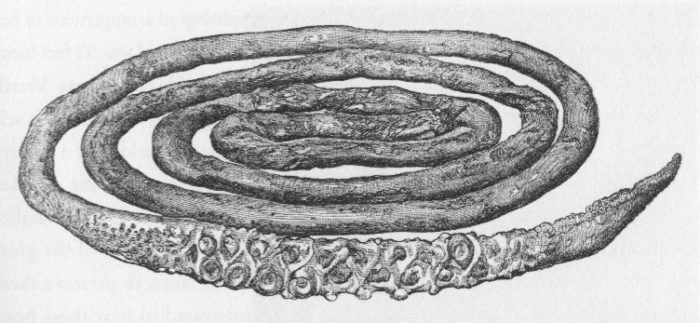
Sketch of a giant squid tentacle
It fastened itself to the boat, holding on with its “parrot’s beak” while another huge tentacle shot out and “coiled like a snake around the stern”. Then, another tentacle latched on to the boat. As the squid began to submerge below the surface of the water, it was obvious to those on board what its plan was – it was attempting to drag them below the water with it.
Piccot’s 12-year-old son was also on board. He would grab a hatchet and quickly hack away at the tentacle, eventually severing it and forcing the creature to relinquish its grip. As it disappeared, a pool of dark, black ink was visible on the water.
According to reports in the local newspapers of the time, [4] the fishermen would retain the tentacle and take it back to shore with them. One reporter who examined it would claim that it was 19 feet in length. Furthermore, according to the report, the tentacle was given to the St. John’s Museum.
The Many Strange Aquatic Creatures Of The United States
Much like the waterways and coastal areas of Canada, another North American country, the United States, also boasts a small plethora of legends and accounts of beastly creatures lurking deep under the ancient lakes and rivers of the country. And while there are several different creatures – at least according to the legends and folklore of the United States – there are also many similarities among the reports.
For example, according to legend, Lake Tahoe – which flows between the states of Nevada and California – is home to Tahoe Tessie, a similar creature (according to descriptions) as that of the Loch Ness Monster in Scotland. A similar “Nessie-like” creature is said to call the Hudson River in New York home, and consequently takes its name (the Hudson River Monster) from the river. Sightings of the creature stretch across the 20th century, with several significant articles appearing in the New York Times, perhaps lending the sightings a little more credibility.
Another such creature, according to local legend, resides in the Great Salt Lake of Utah. The North Shore Monster is said to have the body of a crocodile and the head of a horse. What’s more, it is said to make a bone-chilling noise and even aggressively charge toward those who might find themselves too close to it. Perhaps the most famous sighting occurred in the summer of 1877 when several employees of the Salt Works Company witnessed the huge creature emerge from the water from the plant on the shore.
Some of these strange and mostly elusive aquatic anomalies, however, stand out more than others.
The White River Monster Of Arkansas
One of the most well-known creatures lurking in the American waters [5] is the White River Monster that is said to reside in the White River in Arkansas. While all the official sightings are from the early 20th century onwards, there are some reports that the creature overturned a boat during the American Civil War. The reports, however, are more hearsay than anything else, although the fact the incident is still spoken about might suggest there is at least something in the account.
The first official sighting took place on 1st July 1915 when a plantation owner claimed to see a gray-colored creature that was approximately the size of a car in width and “three cars long”. Although interest in the sighting continued over the years, as did semi-regular sightings of what could be the creature, the next sighting of real significance took place in January 1937.
What is interesting about the sighting – aside from the fact there were multiple witnesses – is that the descriptions given were remarkably similar to those given over two decades earlier. Local fishermen would report to a nearby plantation owner that not only were they finding it hard to catch any fish (with no good reason why), but that they had also seen something strange in the water.
When the plantation owner, Bramlett Bateman, accompanied the men back to the river, he too witnessed the strange creature. He would describe it as being a large creature “with the skin of an elephant”. What’s more, the dimensions of the creature would match those (approximately) as those given by the plantation owner in 1915. There were two well-publicized sightings in the early 1970s, with several sightings throughout 1971, in particular.
The short video below looks at the White River Monster a little further.
Flathead Lake Monster
According to Montana legends and folklore, the Flathead Lake Monster, named after the lake it calls home in Montana, has called the lake home for centuries. Native American tribes of the region tell of witnesses seeing antlers sticking through the ice of the lake. They would attempt to saw them off until the ice below began to shake. It then began to splinter and fall away as the head of the beastly monster emerged in front of them.
In more recent times following the arrival of European settlers to the area, many sightings began to be reported in the local newspapers. The first reported sighting of the (relative) modern era is largely agreed to have occurred in 1889 when the captain of a steamboat, James C. Kerr, would claim he had witnessed the strange creature. And what’s more, over 100 passengers and crew also witnessed it, including one who would attempt to shoot the creature.
A local researcher and former newspaper editor, Paul FugleBerg, has conducted extensive research on the history of the sightings of the creature. And sightings of the Flathead Lake Monster continue to be reported. However, it also appears to be the case that many people who witness the strange creature fear reporting it in case they face ridicule or even accusations of outright lying.
What is interesting about the sightings, certainly in the contemporary era, is that very few, if any, people who claim to have witnessed the monster of Flathead Lake claim that there appears to be “nothing to be afraid of” and that there is nothing aggressive about it. Like many of the other creatures we have looked at here, only further study will resolve the issue as to whether the monster is indeed real or not.
Check out the short video below.
The Bear Lake Monster
Another monstrous creature said to call the American water networks home is the Bear Lake Monster, who legend states resides in Bear Lake which flows along the Idaho-Utah border. Like many of the other aquatic creatures around America, sightings began to be reported and documented as settlers from Europe spread across the country in the 19th century. In reality, however, assuming there is some truth in the presence of the strange creature, sightings have likely happened for hundreds of years.
The general descriptions of the Bear Lake Monster are rather terrifying, with most describing it as a serpent with legs. Approximate measurements suggest the creature is around 30 feet long.
While there is considerable doubt around the sighting – mainly from the apparent admission of fabrication of accounts by Joseph Rich in 1868 – many people of the local populations around the lake maintain there is something in the sightings, with some even claiming to have seen it themselves. It is certainly not beyond the realm of possibility that while Rich certainly was a little too eager in putting the accounts across that there still might be some truth to the notion of a strange aquatic animal residing in the lake along the Idaho-Utah border.
The last recorded sighting of the creature was as recently as June 2002 when a business owner at Bear Lake would make claims of seeing the strange serpent-like creature. There are also other sightings throughout the 20th century, including a Boy Scout leader who would claim to have an up-close encounter with it in 1946. Like other alleged creatures of the American rivers and lakes, it is also likely that many sightings go unreported.
You can check out the video below. It looks at the legends surround the Bear Lake Monster in a little more detail.
The Bunyip Legends Of Australia
One of the most disturbing legends of aquatic beasts can be found in Australia in the form of the Bunyip. And like others in our examination of such strange creatures, tales of them date back to at least the 1800s. As we will examine shortly, however, it is most likely that these creatures have been calling the waters in and around Australia home for much longer.
The origins of the accounts come from the Aboriginal myths and legends, many of which date back thousands of years. When European settlers came to the region in the early 19th century, however, they too began witnessing and recording such strange encounters.
According to the plethora of accounts on record, the Bunyip is an aquatic mammal with smooth skin and strange eyes with a slightly orange glow. What’s more, it had a cry that could be heard for a considerable distance.
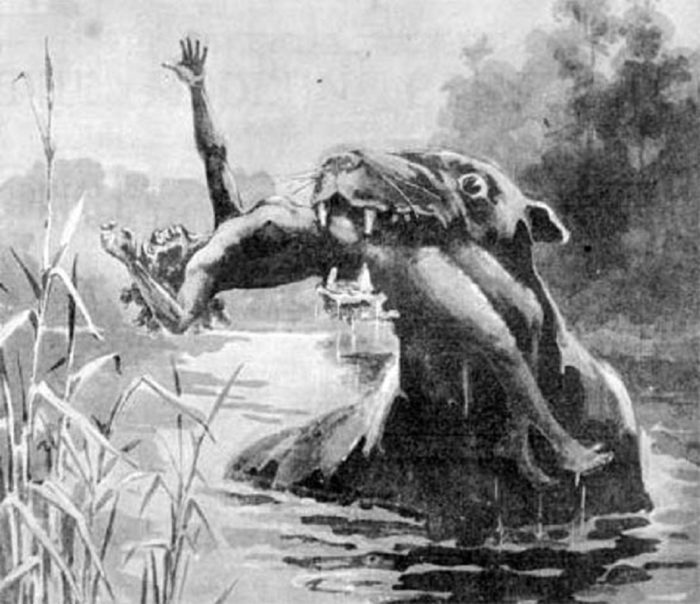
Depiction of the legendary Bunyip
Even more disturbing, for those unfortunate enough to go too close to the water when the creature was lurking was likely to be eaten. What’s more, rather than one specific location, Bunyip sightings are spread around multiple rivers, lakes, and swamps in the New South Wales region.
Unlike many of the other sea creatures we have examined here, many legends of the Bunyip state it has supernatural abilities, apparently being able to hypnotize its victims. This is particularly concerning as those same legends state that it sometimes uses the cover of darkness to stalk and attack women and children.
One particularly interesting account states that in 1851 – according to the Australasian newspaper – a Bunyip was killed by an Aboriginal tribesman. What’s more, its body was apparently left on display where people would come to walk around the carcass, outlining its form as it did so. The location, however, is now lost.
Discovery Of Cave Paintings Suggests The Creature Goes Back To Antiquity
A discovery of Aboriginal artwork in the caves of Grampian National Park in Victoria might prove to be of importance, not only to date how far back sightings of the Bunyip creature go but as a testament to the fact that Aboriginal people witnessed the creature themselves.
In the cave is a painting in red-ochre of what is clearly four Bunyip creatures. What’s more, the painting could be anywhere from a few thousand to tens of thousands of years in age. This would suggest the very real possibility that the Aboriginal people of ancient times witnessed a Bunyip in the flesh.
What perhaps makes the discovery of the cave painting showing this apparently mythical creature even more interesting is that in the last few years, a video emerged claiming to show a strange creature moving through the water before attacking and eating a horse. Whether the footage was authentic or not, however, remains open to debate.
What is intriguing about the Bunyip – especially when we consider the apparent supernatural abilities is said to have – are the rather unique descriptions. Some state it has the body of a snake (which might explain the legends of it “hugging” its victims to death) but it has a mixture of a crocodile-type head and the face of a dog. It also is said to have claws as well as large tusks and is covered in fur. It is also said to be able to move extremely quickly.
Many Sightings And Discoveries
There have been multiple sightings [6] of the Bunyip on record, including apparent discoveries of fossils and remains of the creature. For example, in 1818, two men, Hamilton Hume and James Meehan would discover a skeleton of an animal. One so large and strange that they could not take a guess as to what it might have been. Their descriptions, however, would match later details of the Bunyip.
Three years later in 1821, came the first recorded encounter between a person an apparent live Bunyip. While walking near Lake Bathurst South, E. S. Hall would claim to witness a strange creature with “jet-black hair” in a marshy area that flowed into the lake.
Six years later in 1827 came another sighting when European settlers witness an almost identical creature emerging from a lagoon near their home. Yet another sighting occurred in the same area the following year.
Another discovery of strange skeletal remains would come in 1830 when George Ranken would find the bones in the Wellington Caves. He would go on to describe the remains as belonging to something that was “quadruped (in size) than the ox of Buffalo”.
In 1847 came another sighting. This time, a shepherd claimed to have seen the creature that was “dark brown with a long neck and a pointed head”. Even stranger, when the shepherd made a noise in an attempt to back up he noticed the ears of the creature move in his direction. He would make a run for it, but when he returned a little later he noticed there were large, square tracks in the mud of the water’s edge.
The last officially recorded sighting came in 1890 when a resident spotted the creature near a lagoon. He would attempt to shoot at it but it simply let out a roar and disappeared into the water.
The Lake Tianchi Monster
Whether sightings of the Lake Tianchi Monster of Lake Tianchi (sometimes called Heaven’s Lake) in the Baekdudaegan and Changbai mountain ranges in China, the first officially recorded sighting [7] was in 1903. On that occasion, multiple people witnessed a strange “buffalo-like” creature suddenly emerge from the water and head straight in their direction. The three witnesses managed to fire several shots in their direction which caused the strange creature to head back into the water where it disappeared.
It would be over half a century before the next sighting, but the creature was witnessed by, according to some reports, hundreds of people. In late August 1962, the main witness to the incident would spot what he would later describe as two of the strange creatures giving chase to one another in the water. He viewed the events with his telescope and so would give a detailed account. Whether genuine or not, the report of the incident would result in a plethora of accounts over the next several days.
Even as late as the summer of 2003 reports of the Lake Tianchi Monster can be found. On this occasion, a dozen soldiers of the Chinese army would all claim to have seen an ominous dark creature with horns on its head moving in the water. It remained visible for several minutes before simply disappearing back beneath the waves. Four years later in the summer of 2007, journalist, Zhuo Yongsheng would capture several minutes of video footage that he claimed was the Lake Tianchi Monster.
Due to considerable volcanic activity deep under the water, not to mention the drastically cold temperatures of the lake, many skeptics refuse to believe any such creature could survive in such an environment. Indeed, most sightings are put down to the volcanic activity itself.
The Monster Of Lake Tota
If we turn our attention to South America, we can find the equally intriguing legends of the Monster of Lake Tota in Columbia. Lake Tota itself is the largest lake in the country, covering a vast 21 square miles – plenty of room to accommodate one or more of these behemoth-like creatures.
It would appear that the first recording of the creature goes back to the 16th century when Spanish explorer, Gonzalo Jimenez de Quesada heard of the “black monster” from the indigenous people of the area. They would, in fact, state their belief that the creature was demonic and that the Lake itself was not to be crossed.
In 1652 came one of the first actual sightings of the creature when a priest, Lucas Fernandez de Piedrahita would document an encounter with a “black fish larger than a whale” and with “the head similar to an ox”. Similar to the account relayed by Quesada, locals would state that the creature was nothing less than “the Devil”.
While there are few sightings, or at least reports of them today, the legend persists of the strange black “devil whale” that haunts the waters of Lake Tota.
Russia’s The Brosno Dragon – An Aquatic Legend In Truly Ominous Surroundings!
Without a doubt, one of the most intriguing legends of aquatic creatures comes from Russia. Tales and apparent sightings of the Brosno Dragon [8] in and around Lake Brosno near Andreapol in the west of the country date back as far as the 13th century when legends state that the approaching Tatar-Mongol army witnessed the dragon coming up out of the water and immediately retreated.
Similar legends exist, claiming that those who ventured down the lake to hide treasure would meet their end at the hands of the Brosno Dragon. Some accounts from folklore even speak of a huge mouth simply waiting under the water and then opening and “swallowing boats whole”. A similar account is on record in the (relatively) recent times of the Second World War when a crashed German warplane was said to be swallowed up by the beast.
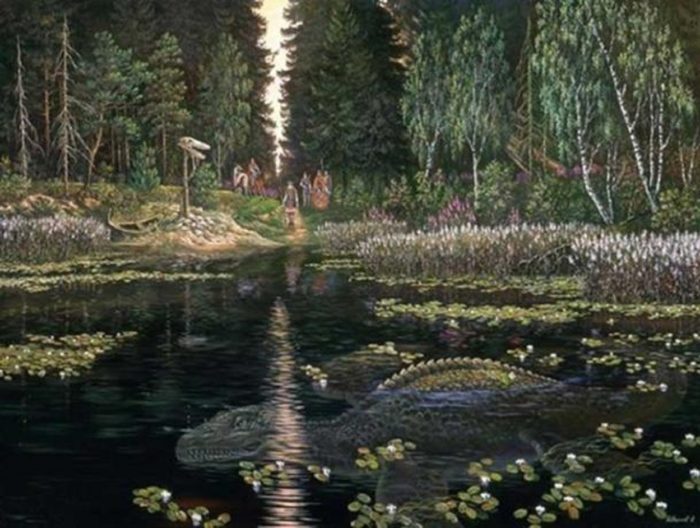
Depiction of the Brosno Dragon
What perhaps makes the accounts of the creature even more unnerving is that the area where it is supposed to reside is surrounded by abandoned villages. Even more disturbing to the atmosphere of the region is a church that has sunken into one side of the lake. It is not known how old the church is or who might have used it and when.
Sightings still do continue today, although they are fewer. What is perhaps interesting is that many of the sightings of the modern era speak of a strange creature surfacing in the water – usually at night. However, rather than acting aggressively, when people have attempted to approach it, it is said to have simply disappeared back under the water.
Might this suggest that while the tales of a strange creature in Lake Brosno have more truth than we might think, although the accounts in the past were obviously overblown and overdramatized?
Lake Gas? Trick Of The Light? Or A Genuine Unclassified Aquatic Species?
There are several interesting theories as to what the Brosno Dragon – assuming it isn’t the legendary monster from Russian folklore – might actually be. One, for example, is one that will be familiar to many UFO researchers in that the Brosno Dragon is, in reality, nothing more than hydrogen sulfide rising from the bottom of the waters and causing bubbles, and then “boiling” to form on the surface. It is this boiling, some claim, that people throughout the centuries have mistaken for a literal dragon rising out of the waters. Other claim rather than gas causing such boiling on the water’s surface, a volcano deep below the surface is the true culprit.
Other researchers suggest that smelt shoals at the bottom of the water give the appearance of a reptilian head when they reflect on the surface of the water, and these are the likely cause of the sightings. Others still suggest that the “dragon” may be nothing more than a fish that has managed to live well past 100 years in age and so consequently has grown much larger than normal.
Whether the creature exists or not is obviously open to debate. However, local media apparently regularly report on the creature. And there are several cases of people disappearing in the area which are blamed on the creature by some.
It is perhaps interesting that it is described as a dragon given that many who believe such large aquatic creatures do exist have theorized that they could well be related to dinosaurs, or that they are indeed from that era and has somehow managed to survive, largely undetected through the centuries. And consequently, a creature that is not on record as having ever existed.
The 2002 Research Mission That Detected A “Mass” At The Bottom Of Lake Brosna
What is perhaps interesting, though, is a research mission undertaken by scientists from the Kosmopoisk research association in 2002 in an attempt to see how real the legends of the Brosno Dragon might be.
They would use deep echo sound equipment to detect anything unusual below the water. Rather amazingly, they did discover something strange. According to their results, a “jelly-like” mass was present at the bottom of the water. What’s more, it was approximately the same size as a railway cart. Even stranger, this mass was not sat on the bed of the lake, but hovering around 15 feet from the bed of the lake.
The team was unable to obtain any more details, but their findings are extremely intriguing. The fact that Brosno Lake is set away from highly populated towns – as we mentioned above it is surrounded by deserted villages – gives it the perfect place to reside, away from the encroachment of the modern world. Perhaps the creature’s presence is the reason why such villages have remained abandoned.
The short video below examines the legend a little further.
The Mahamba Of The Democratic Republic Of Congo – Another Link To The Dinosaurs?
Like some of the other strange creatures we have examined, the Mahamba of the Democratic Republic of Congo in Africa is a creature that many researchers [9] believe to be one from the dinosaur age that simply didn’t die out. Many researchers compare the Mahamba to the Mosasaur, which according to reports, had a very similar appearance to the crocodile-like creatures apparently spotted in the Congo rivers in the modern era.
Whether that assessment by those who have studied the sightings is accurate or not remains to be seen. However, it is known that crocodiles can reach huge sizes.
There are certainly plenty of sightings on record, though. Spencer St. John would write of his sighting of crocodile-like creature in the Linggar River that was almost 25 feet long in Life in the Forest of the Far East. W H Marshall would write of an “alligator of enormous length” that was moving “against the tide” at a high rate of speed.
In the 19th century Belgian explorer, John Reinhardt Werner would claim to have witnessed the “biggest crocodile I have ever seen”, going on to state that it was “50 feet long” and that the “saw-ridged back” was almost five feet from the ground when stood. What’s more, when this “crocodile” moved back into the waters, it moved with astonishing speed and ultimately disappeared.
The short video below looks at the legends of the Mahamba creature in a little more detail.
Another Example Of Myth And Legend Contain Partial Truths?
As we have seen, in the short space and time we have here, there is an absolute abundance of accounts on record and an equal number of legends that stretch back centuries. As we have examined before, might the modern-day sightings prove that there are some truth and fact to be found in the legends and myths of old? Might it be that sightings of these strange creatures hundreds of years ago could be explained by scientists and cryptozoologists if only they had the chance to witness them for themselves and study them close up?
The fact that these strange and ultimately elusive creatures continue to be seen – and in some cases filmed, albeit from a distance and with little clarity – should alert us to the fact that something very real awaits our discovery. And, as is most often the case, one discovery usually leads to another, and then another, and then ultimately a greater understanding of previously unconnected mysterious.
That strange and unknown species reside under our oceans, lakes, and rivers, while certainly not being factually proven, is surely highly likely, if not very probable. That these creatures will be familiar with their aquatic terrain more than we can ever hope to be is perhaps what keeps their existence unproven and why sightings of them are fleeting at best.
What’s more, rather than being one particular new species awaiting our discovery, it is also likely that several such species reside under the murky depths of the world’s water systems and oceans. Much like UFOs, extraterrestrials, claims of Bigfoot or Sasquatch, only further study and research of these seemingly gigantic creatures will get to the truth of the many claims and accounts available to us.
The video below looks at strange cases of sea monsters.
References
| ↑1 | Cadboro Bay Sea Monster Hunt is Underway in British Columbia, Paul Seaburn, Mysterious Universe, May 31st, 2019 https://mysteriousuniverse.org/2019/05/cadboro-bay-sea-monster-hunt-is-underway-in-british-columbia/ |
|---|---|
| ↑2 | Does Ogopogo Exist? The Mystery of Lake Okanagan https://ogopogoquest.com/sightings.php |
| ↑3 | The Atlantic Coast: A Natural History, Harry Thurston, ISBN 9781553 654469 (page 245) |
| ↑4 | 1873, October 25 (ca.): Theophilus Picot and the Giant Squid, Anomalies http://anomalyinfo.com/Stories/1873-october-26-theophilus-picot-giant-squid |
| ↑5 | White River Monster, Encyclopedia of Arkansas https://encyclopediaofarkansas.net/entries/white-river-monster-2790/ |
| ↑6 | The Bunyip, Adam Benedict, Pine Barren Institute June 14th, 2019 https://pinebarrensinstitute.com/guest-articles/2019/6/14/the-bunyip-guest-article-by-slapped-ham |
| ↑7 | Mysterious Lake Monsters of China, Brent Swancer, Mysterious Universe, February 19th, 2019 https://mysteriousuniverse.org/2019/02/mysterious-lake-monsters-of-china/ |
| ↑8 | The Brosno Dragon: The Loch Ness Monster’s Evil Russian Cousin?, Sarah P Young, Ancient Origins, May 23rd, 2019 https://www.ancient-origins.net/myths-legends-europe/brosno-dragon-0011946 |
| ↑9 | The Mahamba https://thecryptokitten.weebly.com/the-mahamba.html |
Fact Checking/Disclaimer
The stories, accounts, and discussions in this article may go against currently accepted science and common beliefs. The details included in the article are based on the reports, accounts and documentation available as provided by witnesses and publications - sources/references are published above.
We do not aim to prove nor disprove any of the theories, cases, or reports. You should read this article with an open mind and come to a conclusion yourself. Our motto always is, "you make up your own mind". Read more about how we fact-check content here.
Copyright & Republishing Policy
The entire article and the contents within are published by, wholly-owned and copyright of UFO Insight. The author does not own the rights to this content.
You may republish short quotes from this article with a reference back to the original UFO Insight article here as the source. You may not republish the article in its entirety.



